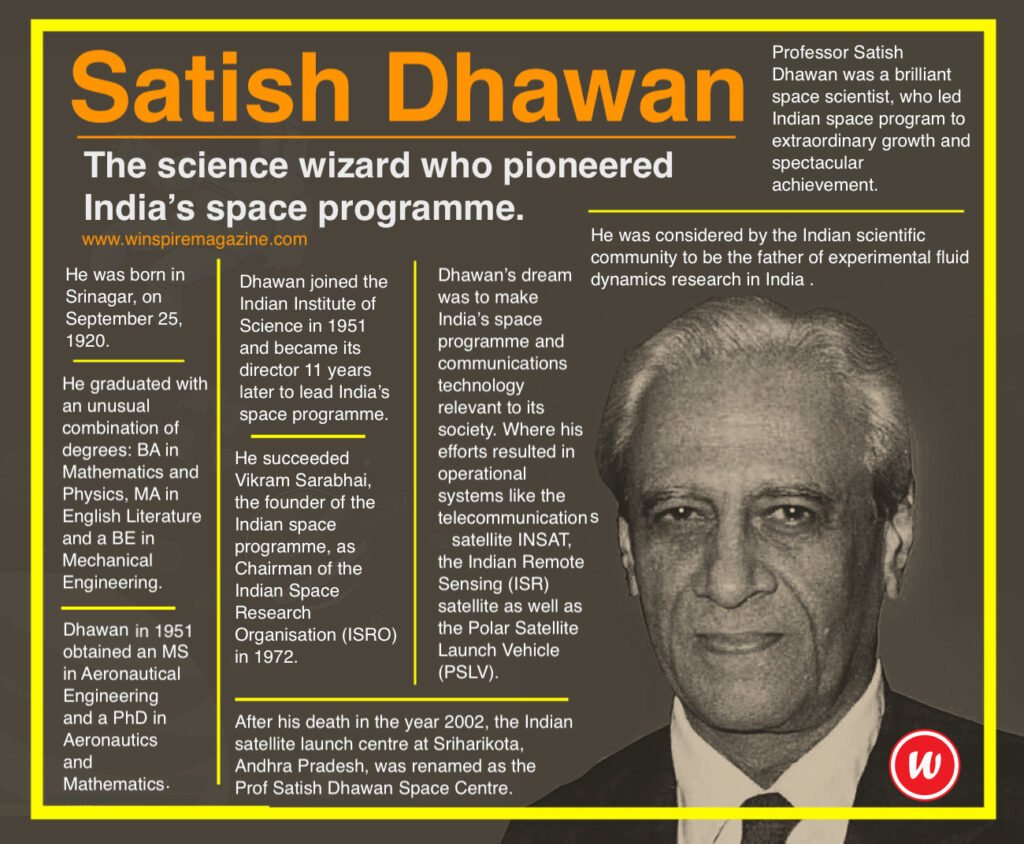The Man Behind Indian Space Programme: Satish Dhawan

Professor Satish Dhawan was a splendid space scientist who led the Indian space program to remarkable growth and magnificent achievement.
A rocket scientist, he was recognized by the Indian scientific community to be the father of experimental fluid dynamics research in India and was one of the most prominent researchers in the area of turbulence and barrier layers.
Early Life:
- Born in Srinagar, Jammu & Kashmir on September 25, 1920, into a noble family. His father was a high-ranking civil servant and retired as the resettlement Commissioner of Government of India.
- Graduation from the University of Punjab with BA in (Mathematics and Physics), MA in (English Literature) and a BE in (Mechanical Engineering)
- In the year 1947, Dhawan completed his MS in (Aeronautical Engineering) from the University of Minnesota and moved to the California Institute of Technology, where he was awarded the Aeronautical Engineer’s Degree in 1949.
- He completed his PhD in Aeronautics and Mathematics from Caltech in 1951.
Career:
- In the year 1951, Prof Dhawan joined the Indian Institute of Science, Banglore as Senior Scientific Officer, later in 1962, he became the Director of the Institution. He was the youngest director to be appointed to this prestigious position and, remain the longest-serving, and undoubtedly the most famous.
- In 1971, Dhawan went for one year’s sabbatical to Caltech, his alma mater in the USA.
- But he was requested to return and take charge of Indian Space Programme due to sudden death of Vikram Sarabhai(Founder of ISRO).
- Sarabhai’s association with Dhawan had already begun earlier when he asked Dhawan for technical advice in installing up a solid rocket motor equipment in India.
- He was appointed as Chairman of the Indian Space Research Organisation (ISRO) in 1972 and continued as IISC’s Director as well.
- In May 1972, He was also the Chairman of the Space Commission and Secretary to the Government of India in the Department of Space.

Dhawan as Leader:
Ever since, these three posts have been concurrently held — guaranteeing seamless alliance between conceptualization, funding of programmes, and up-to-date delivery of technologies! Such was his dynamism and commitment towards his work.
In the decade that followed, Dhawan guided the Indian space programme an effective management structure that boosted innovation.
In this system, the project director led over a small team of experts from different centres. This ensured that independent efforts and co-ordinated and channelized towards a common goal – be it a satellite or a launch vehicle. Clarity and professionalism were also encouraged. He was the reason for hand-picking young, bright and dedicated professionals for ISRO, such as:
- APJ Abdul Kalam to lead the project that developed SLV-3, India’s first launch vehicle,
- Roddam Narasimha to lead the research being done at NAL,
- UR Rao to head the team that made the country’s first satellite, Aryabhata.
To encourage youngsters, he gives them credit for success and takes responsibility in case of failure.
In this regard, former President APJ Abdul Kalam had once recounted his experiences as the project director for the launch of India’s first launch vehicle, SLV-3.
The first experimental launch of SLV-3 took place on August 10, 1979, but it was a failure. Dhawan went to the conference himself and said,
“Friends, today we had our first satellite launch vehicle to put a satellite in orbit. We could not succeed. In many technologies, we have succeeded, and in a few more, we have yet to succeed. Above all, I realise my team members have to be given all technological support. I am going to do that, and the next mission will succeed.”
The next time SLV-3 was launched (on July 18, 1980), it was a sensational success. This time, Dhawan asked Kalam to handle the press conference along with his team members.
“Professor Dhawan’s management philosophy was that when success comes in after hard work, the leader should give the credit of the success to the team members. When failure comes, the leader should absorb the failures and protect the team members,” recounted Dr Kalam.
Under Dhawan’s aegis, ISRO also operated towards achieving Vikram Sarabhai’s dream of using space science to address the development needs India. As such, pioneering programmes and carefully thought out experiments were carried out in rural education, remote sensing and satellite communications.
Achievements & Awards:
- Prof Dhawan’s essential contributions are presented in the seminal book Boundary Layer Theory by Hermann Schlichting.
- He is credited for setting up the first supersonic wind tunnel in India at IISc.
- Dhawan received Padma Vibhushan (India’s second-highest civilian honour), in 1981.
- Dhawan was awarded Padma Bhushan (India’s third highest civilian honour), in 1971.
- Indira Gandhi Award for National Integration, 1999.
- Distinguished Alumnus Award, Indian Institute of Science, Banglore.
- Distinguished Alumnus Award, California Insititute of Technology, 1969.
- After his death in the year 2002, the Indian satellite launch centre at Sriharikota, Andhra Pradesh, was renamed as the Prof Satish Dhawan Space Centre.
We’ve created this content for informational purposes only, and it reflects the views of its respective authors/entities (freelancers/interns) and not those of Winspire Magazine. Winspire Magazine does not endorse or vouch for the accuracy of the information provided in this content. It is the reader’s responsibility to verify and ensure the information is correct and up-to-date. Winspire Magazine disclaims any liability or responsibility for any damages or losses from using this content. Therefore, readers should take all necessary steps to verify the accuracy and reliability of any information presented in this content.


